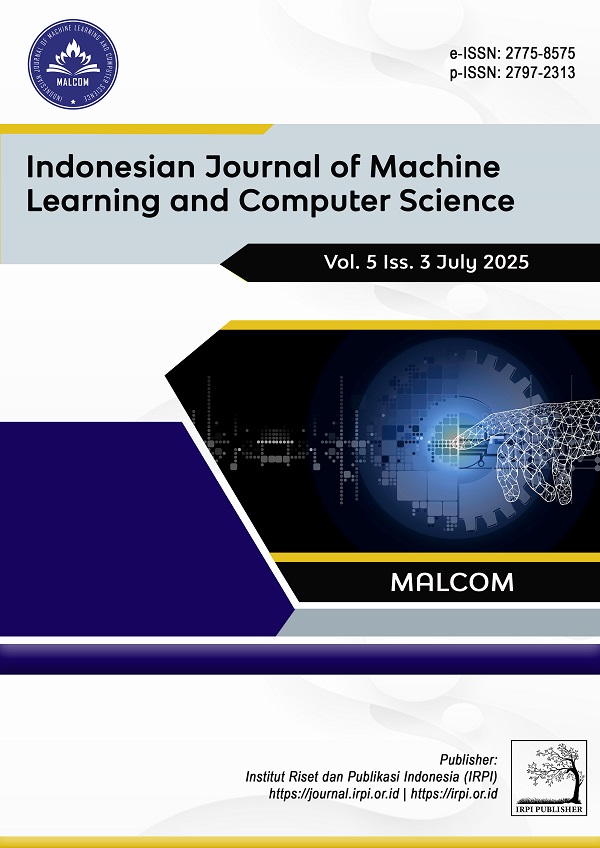Internet of Things Based Air Quality Monitoring System with Automatic Notification
DOI:
https://doi.org/10.57152/malcom.v5i3.1945Keywords:
Air Quality Monitoring, Automatic Alerts, Cloud Computing, IoT Sensors, Machine LearningAbstract
Internet of Things (IoT)-based air quality monitoring systems represent a significant advancement in urban environmental management. This research implements a system that integrates PM2.5, PM10, CO2, and NO2 sensors for real-time monitoring of pollutants. The results showed that the integration of IoT technology with cloud computing and machine learning algorithms successfully created a responsive and accurate monitoring system. The model achieved maximum accuracy during the training process, with promising predictive capabilities in real-world implementation. The main findings of the study confirmed that the Weighted Class (WC) approach significantly improved performance in the testing and prediction process by addressing class imbalance in the dataset, while the Data Augmentation (DA) technique did not show the expected improvement due to the intrinsic characteristics of air quality data. The automatic notification system successfully provides early warnings when air quality exceeds specified thresholds, enabling proactive responses from authorities and the public. The implementation of a web-based monitoring dashboard provides comprehensive visualization of data for long-term analysis. This research contributes to the development of smart cities by providing an effective framework for air quality management, supporting data-driven decision-making, and increasing public awareness of environmental conditions.
Downloads
References
H. Karnati, “IoT-Based Air Quality Monitoring System with Machine Learning for Accurate and Real-time Data Analysis,” pp. 2–19, 2023, [Online]. Available: http://arxiv.org/abs/2307.00580
H. F. Hawari, A. A. Zainal, and M. R. Ahmad, “Development of real time internet of things (IoT) based air quality monitoring system,” Indones. J. Electr. Eng. Comput. Sci., vol. 13, no. 3, pp. 1039–1047, 2019, doi: 10.11591/ijeecs.v13.i3.pp1039-1047.
D. A. Martillano, L. V. A. Dela Cuesta, K. R. V. Mariano, and V. C. Q. Mesina, “Multi zone-based surface air quality monitoring via internet of things,” J. Commun., vol. 14, no. 6, pp. 470–477, 2019, doi: 10.12720/jcm.14.6.470-477.
N. Chavhan, R. Bhattad, S. Khot, S. Patil, and A. Pawar, “APAH?: An autonomous IoT driven real-time monitoring system for Industrial wastewater,” Digit. Chem. Eng., vol. 14, no. September 2024, p. 100217, 2025, doi: 10.1016/j.dche.2025.100217.
W. A. Jabbar, T. Subramaniam, A. E. Ong, M. I. Shu’Ib, W. Wu, and M. A. de Oliveira, “LoRaWAN-Based IoT System Implementation for Long-Range Outdoor Air Quality Monitoring,” Internet of Things (Netherlands), vol. 19, no. November 2021, p. 100540, 2022, doi: 10.1016/j.iot.2022.100540.
J. M. S. Waworundeng and O. Lengkong, “Sistem Monitoring dan Notifikasi Kualitas Udara dalam Ruangan dengan Platform IoT,” CogITo Smart J., vol. 4, no. 1, pp. 94–103, 2018, doi: 10.31154/cogito.v4i1.105.94-103.
M. R. Al Mamun, M. Ashik-E-Rabbani, M. M. Haque, and S. M. Upoma, “IoT-based real-time biofloc monitoring and controlling system,” Smart Agric. Technol., vol. 9, no. September, p. 100598, 2024, doi: 10.1016/j.atech.2024.100598.
N. Agarwal et al., “Indoor air quality improvement in COVID-19 pandemic: Review,” Sustain. Cities Soc., vol. 70, no. April, p. 102942, 2021, doi: 10.1016/j.scs.2021.102942.
V. E. Alvear-Puertas, Y. A. Burbano-Prado, P. D. Rosero-Montalvo, P. Tözün, F. Marcillo, and W. Hernandez, “Smart and Portable Air-Quality Monitoring IoT Low-Cost Devices in Ibarra City, Ecuador,” Sensors, vol. 22, no. 18, pp. 1–17, 2022, doi: 10.3390/s22187015.
S. Abimannan et al., “Towards Federated Learning and Multi-Access Edge Computing for Air Quality Monitoring: Literature Review and Assessment,” Sustain., vol. 15, no. 18, pp. 1–34, 2023, doi: 10.3390/su151813951.
S. L. Ullo and G. R. Sinha, “Advances in smart environment monitoring systems using iot and sensors,” Sensors (Switzerland), vol. 20, no. 11, 2020, doi: 10.3390/s20113113.
N. S. Baqer, H. A. Mohammed, and A. S. Albahri, “Development of a real-time monitoring and detection indoor air quality system for intensive care unit and emergency department,” Signa Vitae, vol. 19, no. 1, pp. 77–92, 2023, doi: 10.22514/sv.2022.013.
P. Ferrer-Cid, J. M. Barcelo-Ordinas, J. Garcia-Vidal, A. Ripoll, and M. Viana, “Multisensor Data Fusion Calibration in IoT Air Pollution Platforms,” IEEE Internet Things J., vol. 7, no. 4, pp. 3124–3132, 2020, doi: 10.1109/JIOT.2020.2965283.
A. A. Aserkar, S. R. Godla, Y. A. Baker El-Ebiary, Krishnamoorthy, and J. V. N. Ramesh, “Real-time Air Quality Monitoring in Smart Cities using IoT-enabled Advanced Optical Sensors,” Int. J. Adv. Comput. Sci. Appl., vol. 15, no. 4, pp. 840–848, 2024, doi: 10.14569/IJACSA.2024.0150487.
J. H. Jo, B. W. Jo, J. H. Kim, and I. Choi, “Implementation of iot-based air quality monitoring system for investigating particulate matter (Pm10) in subway tunnels,” Int. J. Environ. Res. Public Health, vol. 17, no. 15, pp. 1–12, 2020, doi: 10.3390/ijerph17155429.
S. Kaur and S. Sharma, “IoT-Enabled Air Pollution Monitoring Systems: Technologies, Solutions, and Challenges,” Adv. Transdiscipl. Eng., vol. 32, pp. 347–352, 2023, doi: 10.3233/ATDE221280.
S. Zafar, G. Miraj, R. Baloch, D. Murtaza, and K. Arshad, “Environmental Monitoring System Using IoT and Environmental Monitoring System Using IoT and Cloud Service at Real-Time,” Eng. Technol. Appl. Sci. Res., vol. 8, no. 4, pp. 3238–3242, 2018.
J. Kustija, A. U. Afifah, D. Fahrizal, and I. Surya, “Solutions to Improve Performance of IoT-Based Air Quality Monitoring System to Achieve The Sustainable Development Goals in Indonesian,” E3S Web Conf., vol. 484, 2024, doi: 10.1051/e3sconf/202448403006.
R. Suganya, R. Guhan, N. C. Gowreesan, and Mubariz, “Retraction: Air Quality Monitoring System with Emergency Alerts Using IOT,” J. Phys. Conf. Ser., vol. 1916, no. 1, 2021, doi: 10.1088/1742-6596/1916/1/012050.
M. Ghozi, A. Faris, Z. Reno, and S. Elsi, “Air Quality Monitoring System Based Internet Of Things,” vol. 4, no. 2, pp. 669–673, 2024.
C. N. Lita, A. M. H. Pardede, and S. Syahputra, “Prototype Design IoT Based Air Quality Monitoring Tool for Urban Environment,” vol. 4, no. 1, pp. 2–6, 2024.
J. Waworundeng, “IoT-based Environmental Monitoring with Data Analysis of Temperature, Humidity, and Air Quality,” CogITo Smart J., vol. 10, no. 1, pp. 271–284, 2024, doi: 10.31154/cogito.v10i1.708.692-705.
R. Yunita, “Pengaruh Internet of Things (IoT) terhadap Efisiensi dan Efektivitas Layanan Kesehatan: Tinjauan Literatur,” JR J. Responsive Tek. Inform., vol. 8, no. 01, pp. 12–18, 2024, doi: 10.36352/jr.v8i01.801.
F. P. E. Putra, M. A. Mahmud, and ..., “Pengembangan Sistem Pemantauan Lingkungan Berbasis Internet of Things (IoT) di Kampus,” Digit. Transform. …, vol. 3, no. 2, pp. 996–1001, 2023, [Online]. Available: https://jurnal.itscience.org/index.php/digitech/article/view/3457
M. Iffikrul, A. Suhaidi, N. Hidayah, and M. Yunus, “Development of Blynk IoT-Based Air Quality Monitoring System,” J. Eng. Technol., vol. 9, pp. 63–68, 2021.
I. Budiawan, D. F. Wigianto, B. Wicaksono, and A. R. Hakim, “Air Quality Monitoring System Design Based on Wireless Sensor Network Integrated with the Internet of Things,” Ultim. Comput. J. Sist. Komput., vol. 16, no. 2, pp. 33–38, 2024, doi: 10.31937/sk.v16i1.3694.
A. B. Pratomo, H. N. Muthmainah, N. Kristiono, and G. C. Setyawan, “Implementation of Internet of Things (IoT) Technology in Air Pollution Monitoring in Jakarta: Quantitative Analysis of the Influence of Air Quality Change and Its Impact on Public Health in Jakarta,” West Sci. Nat. Technol., vol. 1, no. 01, pp. 40–47, 2023, doi: 10.58812/wsnt.v1i01.225.
A. Alwi Mashuri and N. Zulfa, “Monitoring System Transportation using Air Quality Based on IoT in Semarang,” J. Penerapan Teknol. dan Pembelajaran, vol. 2, no. 2, pp. 42–49, 2020, [Online]. Available: http://journal.unnes.ac.id/nju/index.php/rekayasa
M. Eriyadi, D. Notosudjono, H. Setiana, and M. A. A. A. Yakin, “Low-cost mobile air quality monitoring based on internet of things for factory area,” Indones. J. Electr. Eng. Comput. Sci., vol. 32, no. 1, pp. 545–554, 2023, doi: 10.11591/ijeecs.v32.i1.pp545-554.
D. Múnera, V. Diana, J. Aguirre, and N. G. Gómez, “IoT-based air quality monitoring systems for smart cities: A systematic mapping study,” Int. J. Electr. Comput. Eng., vol. 11, no. 4, pp. 3470–3482, 2021, doi: 10.11591/ijece.v11i4.pp3470-3482.
H. V and M. L, “IOT-based solution for detection of air quality using ESP32,” Artif. Intell., vol. 28, no. AI.2023.28(3), pp. 86–93, 2023, doi: 10.15407/jai2023.03.086.
J. Kustija, D. Fahrizal, and M. Nasir, “Revitalizing IoT-based air quality monitoring system for major cities in Indonesia,” Sinergi (Indonesia), vol. 28, no. 3, pp. 605–616, 2024, doi: 10.22441/sinergi.2024.3.016.
Downloads
Published
How to Cite
Issue
Section
License
Copyright (c) 2025 Devi Nur Azizah, Sri Heranurweni, La Ode Muhamad Idris

This work is licensed under a Creative Commons Attribution-ShareAlike 4.0 International License.
Copyright © by Author; Published by Institut Riset dan Publikasi Indonesia (IRPI)
This Indonesian Journal of Machine Learning and Computer Science is licensed under a Creative Commons Attribution-ShareAlike 4.0 International License.




















